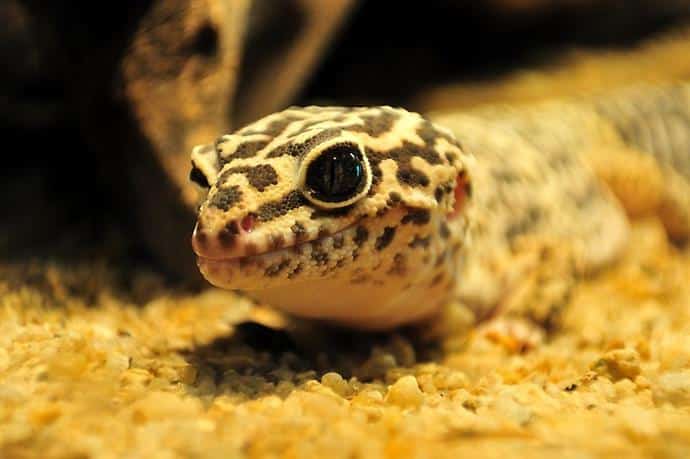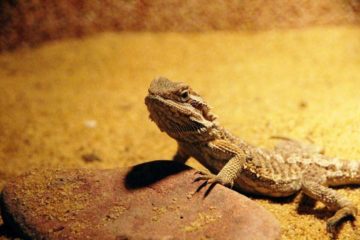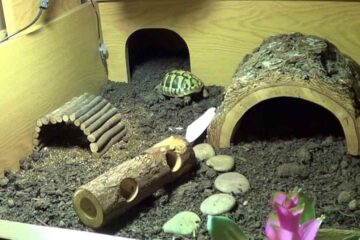This is a very important question, one that not everyone takes the trouble to ask themselves.
In fact, many amateur terrarists want “just a leopard gecko” without wanting to buy a suitable terrarium or what goes with it such as: The substrate
Sommaire
What is a Terrarium substrate?

The substrate is the basic support on which the reptiles or amphibians in your vivarium live (compost, shavings, vermiculite or other). It can also be the base on which plants grow or are planted in a terrarium.
Some substrates, such as calci-sand or excavator, are suitable for animals living in arid zones. Others are ideal for animals living in humid areas and retain moisture (Sphagnum moss, vermiculite).
But which substrates are suitable for a Leopard Gecko?
Although we’ve already covered this question in the Leopard Gecko breeding sheet (which I invite you to read), here’s a slightly more detailed guide to suitable substrates for your gecko with accompanying explanations.
Which substrate for a Leopard Gecko (Eublepharis Macularius)?
Leopard gecko are reptiles that live in arid, semi-arid and even desert areas. So you’ll need a substrate that’s suited to these kinds of places.
Substrates suitable for Leopard Gecko :
Now that you know which substrates are suitable for your eublepharis macularius, let’s take a closer look at them and find out why you should choose one over the other.
Beech chips
This substrate has several qualities that make it ideal.First of all, it’s too big to be ingested, and this is the number 1 criterion when choosing a substrate. This type of substrate is generally sold “clean” to minimize the risk of bacterial growth.
The one below is surely one of the best substrates for a leopard gecko.
- Eclat de hêtre 100% naturel.
- Garanti sans colorants, ni produit chimique.
- Conseillé comme litière pour les serpents, lézards et...
Excavator
Like desert bedding, this substrate is suitable for leopard gecko as it is representative of desert areas. However, it can become too dusty over time, so you need to make sure your reptile doesn’t ingest any. Generally speaking, there’s nothing to worry about, but be careful and change it if necessary.
- Substrats de cage
- Permet aux reptiles de creuser des galeries et des...
- Permet de modeler et de créer des terrasses multiniveaux et...
Thick paper towels
Often used for babies and juvenile reptiles in general, thick paper towel has many qualities. (The thicker the better).
- It enables your young and not-so-young leopard geckos to hunt highly visible prey.
- Droppings are quickly identifiable, and you can remove and replace the dirty paper towel in no time, and at very low cost. The paper towel is therefore hygienic and economical.
- It avoids any risk of ingesting the substrate (unlike sand, for example) during feeding.
⚠ Attention ⚠ : Many breeders use “conventional” sand, which is dangerous for reptiles, especially juveniles! Even if many people make this mistake, don’t copy them, and help them to change!
Substrates to avoid for a leopard gecko
- Sand and “black” sand
- Calci-sand (Sand containing calcium)
- Grass and Moss
Although there are many suitable substrates for the Eublepharis macularius, many can be dangerous. Some are simply difficult to maintain, but others can be extremely dangerous! Such is the case with these.
Sand and Black Sand
Conventional sand, found on the ground or elsewhere, generally contains a large number of bacteria that will be harmful to your reptile. Black sand is cleaner, however, both have the same big problem: The risk of intestinal obstruction due to sand ingestion!
In fact, a reptile that eats sand (involuntarily or not), even in small quantities, risks death or severe stomach pains. To be avoided.
However, a mixture of sand and clay (1/3 and 2/3 respectively) can be considered if it is well made and well compacted.
Calci-sand
This particular sand, as its name suggests, contains calcium. It’s a dangerous way to compensate for your reptile’s calcium deficiency.
Indeed, this sand has the same problem as “normal” sand, namely, the risk of occlusion. What’s more, if your leopard gecko lacks calcium, it will start ingesting this sand voluntarily! This drastically increases the risk, so avoid it.
Grass and moss
These two substrates have several disadvantages:
- As they retain moisture well, they prevent the terrarium from becoming arid, and increase the humidity level.
- Bacteria are more likely to develop there, particularly due to moisture retention.
- They are in no way representative of the lizard’s natural biotope.
Conclusion
As you can see, choosing the ideal substrate for your leopard gecko isn’t that simple. Between health risks, hygiene and comfort, you need to choose carefully, and be aware of the dangers that await your eublepharis macularius.
PS: We can earn a commission if you use our links to buy products. This represents very little money, but allows the site to survive as we don’t advertise. The products we sell are, however, always verified and tested by breeders!


0 Comments